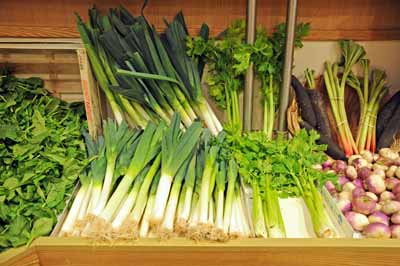
Japanese leek. There are several varieties of Japanese onion, but long onions (naganegi), green onions (bannonegi), and baby scallions (asatsuki) are the most common. The green leaves are a good source of nutrients such as carotene and vitamins B1, B2 and C, and also contain a digestive aid. The white part of the long onion, which generally is preferred to the leaves, should be glossy and firm. It is used in soups and nabe dishes and as a seasoning or condiment. Baby scallions, the thinnest among the onions, are usually chopped and used as a seasoning in soups and nabe (a variety of communal one-pot meals) and noodle dishes.
Dashi is a stock made from kelp and dried bonito flakes. There are three basic types of dashi: Ichiban dashi has a fragrant aroma and delicate flavour and is used mainly in clear soups; Niban dashi is a less refined type often used as a simmering liquid. Both are often used with vegetable dishes rather than meat or fish to achieve a complete balance of flavours. The third type of dashi is Konbu dashi, made only from kelp. It is used with meat and fish dishes, in addition to dishes requiring gentler, unobtrusive seasoning.